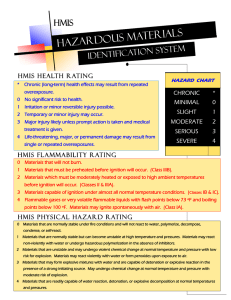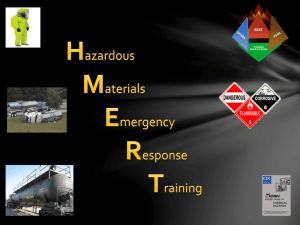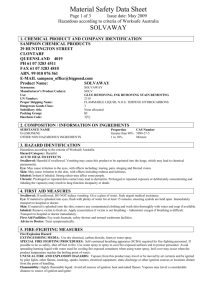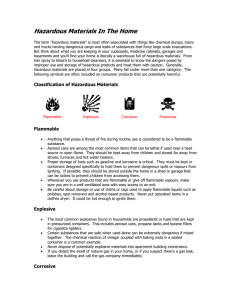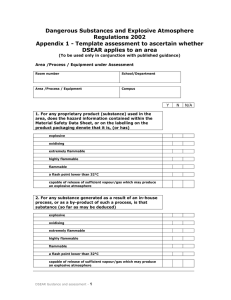Hazardous Area Classification for Flammable Gases and Vapours
advertisement
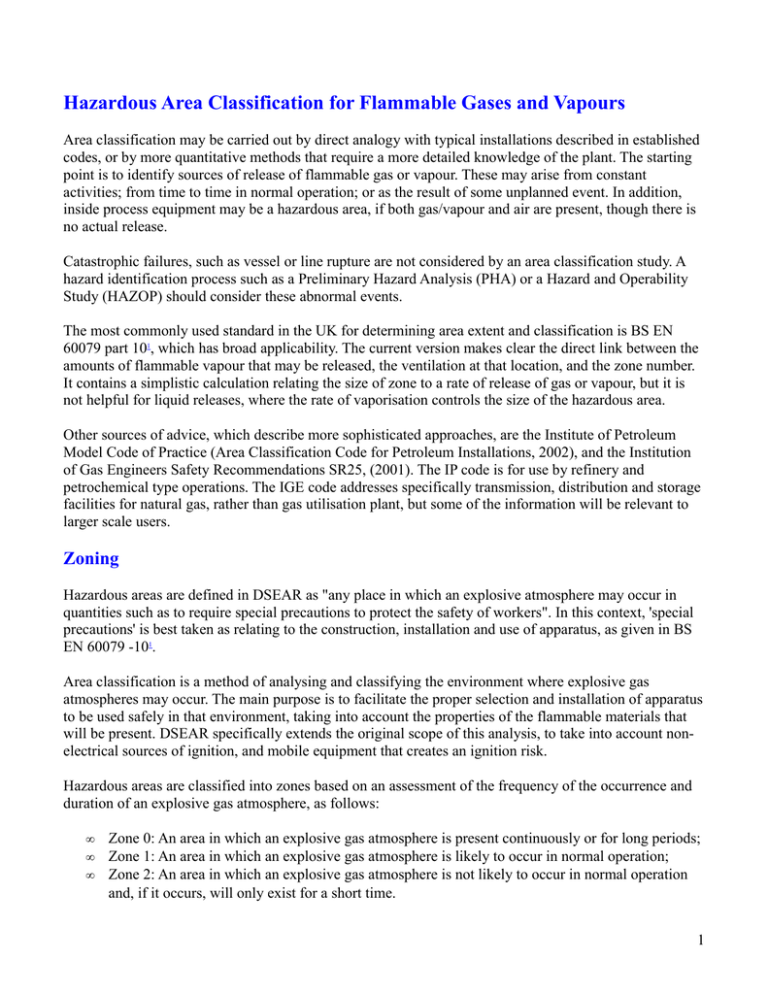
Hazardous Area Classification for Flammable Gases and Vapours Area classification may be carried out by direct analogy with typical installations described in established codes, or by more quantitative methods that require a more detailed knowledge of the plant. The starting point is to identify sources of release of flammable gas or vapour. These may arise from constant activities; from time to time in normal operation; or as the result of some unplanned event. In addition, inside process equipment may be a hazardous area, if both gas/vapour and air are present, though there is no actual release. Catastrophic failures, such as vessel or line rupture are not considered by an area classification study. A hazard identification process such as a Preliminary Hazard Analysis (PHA) or a Hazard and Operability Study (HAZOP) should consider these abnormal events. The most commonly used standard in the UK for determining area extent and classification is BS EN 60079 part 101, which has broad applicability. The current version makes clear the direct link between the amounts of flammable vapour that may be released, the ventilation at that location, and the zone number. It contains a simplistic calculation relating the size of zone to a rate of release of gas or vapour, but it is not helpful for liquid releases, where the rate of vaporisation controls the size of the hazardous area. Other sources of advice, which describe more sophisticated approaches, are the Institute of Petroleum Model Code of Practice (Area Classification Code for Petroleum Installations, 2002), and the Institution of Gas Engineers Safety Recommendations SR25, (2001). The IP code is for use by refinery and petrochemical type operations. The IGE code addresses specifically transmission, distribution and storage facilities for natural gas, rather than gas utilisation plant, but some of the information will be relevant to larger scale users. Zoning Hazardous areas are defined in DSEAR as "any place in which an explosive atmosphere may occur in quantities such as to require special precautions to protect the safety of workers". In this context, 'special precautions' is best taken as relating to the construction, installation and use of apparatus, as given in BS EN 60079 -101. Area classification is a method of analysing and classifying the environment where explosive gas atmospheres may occur. The main purpose is to facilitate the proper selection and installation of apparatus to be used safely in that environment, taking into account the properties of the flammable materials that will be present. DSEAR specifically extends the original scope of this analysis, to take into account nonelectrical sources of ignition, and mobile equipment that creates an ignition risk. Hazardous areas are classified into zones based on an assessment of the frequency of the occurrence and duration of an explosive gas atmosphere, as follows: • • • Zone 0: An area in which an explosive gas atmosphere is present continuously or for long periods; Zone 1: An area in which an explosive gas atmosphere is likely to occur in normal operation; Zone 2: An area in which an explosive gas atmosphere is not likely to occur in normal operation and, if it occurs, will only exist for a short time. 1 Various sources have tried to place time limits on to these zones, but none have been officially adopted. The most common values used are: • • • Zone 0: Explosive atmosphere for more than 1000h/yr Zone 1: Explosive atmosphere for more than 10, but less than 1000 h/yr Zone 2: Explosive atmosphere for less than 10h/yr, but still sufficiently likely as to require controls over ignition sources. Where people wish to quantify the zone definitions, these values are the most appropriate, but for the majority of situations a purely qualitative approach is adequate. When the hazardous areas of a plant have been classified, the remainder will be defined as non-hazardous, sometimes referred to as 'safe areas'. The zone definitions take no account of the consequences of a release. If this aspect is important, it may be addressed by upgrading the specification of equipment or controls over activities allowed within the zone. The alternative of specifying the extent of zones more conservatively is not generally recommended, as it leads to more difficulties with equipment selection, and illogicalities in respect of control over health effects from vapours assumed to be present. Where occupiers choose to define extensive areas as Zone 1, the practical consequences could usefully be discussed during site inspection. As an example: A proposal was made to zone an aircraft hanger as Zone 1, although the use of fuels handled above their flash point would be a rare event. It proved difficult to obtain a floor-cleaning machine certified for Zone 1 areas, though the floor needed sweeping regularly. The option of writing out an exception to normal instructions to allow a non Ex-protected machine to be used regularly is not recommended. Instead, a more realistic assessment of the zones is needed, and special instructions issued for the rare event of using more volatile fuels. A hazardous area extent and classification study involves due consideration and documentation of the following: • • • • • • • The flammable materials that may be present; The physical properties and characteristics of each of the flammable materials; The source of potential releases and how they can form explosive atmospheres; Prevailing operating temperatures and pressures; Presence, degree and availability of ventilation (forced and natural); Dispersion of released vapours to below flammable limits; The probability of each release scenario. These factors enable appropriate selection of zone type and zone extent, and also of equipment. The IP code gives a methodology for estimating release rates from small diameter holes with pressurised sources, and shows how both the buoyancy and momentum of the release influence the extent of a zone. It tabulates values for an LPG mixture, gasoline, natural gas, and refinery hydrogen for pressures up to 100barg. Similarly the IGE code gives a methodology for natural gas, relating the leak rate to the hole2 size and the operating pressure. The tables of dispersion distances to the zone boundary address in the main quite large diameter deliberate vents. There is in practice little overlap between the codes. The results of this work should be documented in Hazardous Area Classification data sheets, supported by appropriate reference drawings showing the extent of the zones around (including above and below where appropriate) the plant item. Selection of Equipment DSEAR sets out the link between zones, and the equipment that may be installed in that zone. This applies to new or newly modified installations. The equipment categories are defined by the ATEX equipment directive, set out in UK law as the Equipment and Protective Systems for Use in Potentially Explosive Atmospheres Regulations 1996. Standards set out different protection concepts, with further subdivisions for some types of equipment according to gas group and temperature classification. Most of the electrical standards have been developed over many years and are now set at international level, while standards for non-electrical equipment are only just becoming available from CEN. The DSEAR ACOP describes the provisions concerning existing equipment. There are different technical means (protection concepts) of building equipment to the different categories. These, the standard current in mid 2003, and the letter giving the type of protection are listed below. Zone 0 Zone 1 Zone 2 Category 1 Category 2 Category 3 'ia' intrinsically safe EN 50020, 2002 'd' - Flameproof enclosure Electrical EN 50018 2000 Type 'n' - EN 50021 1999 Non electrical EN 13463-1, 2001 Ex s - Special protection if specifically certified for Zone 0 'p' - Pressurised EN 50016 2002 'q' - Powder filling EN 50017, 1998 3 'o' - Oil immersion EN 50015, 1998 'e' - Increased safety EN 50019, 2000 'ib' - Intrinsic safety EN 50020, 2002 'm' - Encapsulation EN 50028, 1987 's' - Special protection Correct selection of electrical equipment for hazardous areas requires the following information: • • Classification of the hazardous area (as in zones shown in the table above); Temperature class or ignition temperature of the gas or vapour involved according to the table below: Temperature Classification Maximum Surface Temperature, Ignition Temperature of gas or vapour, °C °C T1 450 >450 T2 300 >300 T3 200 >200 T4 135 >135 T5 100 >100 4 T6 85 >85 If several different flammable materials may be present within a particular area, the material that gives the highest classification dictates the overall area classification. The IP code considers specifically the issue of hydrogen containing process streams as commonly found on refinery plants. Consideration should be shown for flammable material that may be generated due to interaction between chemical species. Ignition Sources - Identification and Control Ignition sources may be: • • • • • • • • • • • • • • • • • • • Flames; Direct fired space and process heating; Use of cigarettes/matches etc; Cutting and welding flames; Hot surfaces; Heated process vessels such as dryers and furnaces; Hot process vessels; Space heating equipment; Mechanical machinery; Electrical equipment and lights Spontaneous heating; Friction heating or sparks; Impact sparks; Sparks from electrical equipment; Stray currents from electrical equipment Electrostatic discharge sparks: Lightning strikes. Electromagnetic radiation of different wavelengths Vehicles, unless specially designed or modified are likely to contain a range of potential ignition sources Sources of ignition should be effectively controlled in all hazardous areas by a combination of design measures, and systems of work: • • • • • Using electrical equipment and instrumentation classified for the zone in which it is located. New mechanical equipment will need to be selected in the same way. (See above); Earthing of all plant/ equipment (see Technical Measures Document on Earthing) Elimination of surfaces above auto-ignition temperatures of flammable materials being handled/stored (see above); Provision of lightning protection Correct selection of vehicles/internal combustion engines that have to work in the zoned areas (see Technical Measures Document on Permit to Work Systems); 5 • • • • • • Correct selection of equipment to avoid high intensity electromagnetic radiation sources, e.g. limitations on the power input to fibre optic systems, avoidance of high intensity lasers or sources of infrared radiation Prohibition of smoking/use of matches/lighters Controls over the use of normal vehicles Controls over activities that create intermittent hazardous areas, e.g. tanker loading/unloading Control of maintenance activities that may cause sparks/hot surfaces/naked flames through a Permit to Work System Precautions to control the risk from pyrophoric scale, usually associated with formation of ferrous sulphide inside process equipment Direct Fired Heaters, Hot Oil Systems and Processes Operating Above AutoIgnition Temperatures A range of petrochemical and refinery processes use direct fired heaters, e.g. steam crackers for ethylene production. Clearly, if the fuel supply to the heater or the pipework carrying the process fluid leaks close to the furnace, any leak must be expected to find a source of ignition, either directly at the flames, or by a surface heated by a flame. In these circumstances, hazardous area classification, and appropriate selection of ATEX equipment is not suitable as a basis of safety for preventing fire and explosion risks. Instead, safety should be achieved by a combination of a high standard of integrity of fuel and process pipelines, together with a means of rapid detection and isolation of any pipes that do fail. The consequences of the failure of a pipe carrying process materials within the furnace should be considered in any HAZOP study. Other processes (such as hot oil heating circuits) may handle products above their auto-ignition temperature. Any such processes should be specifically identified in a safety case. Again, area classification is not a suitable means of controlling the ignition risks, and the same considerations apply, as with fired heaters. Lightning Protection Protection against lightning involves installation of a surge protection device between each non-earth bonded core of the cable and the local structure. Further guidance can be found in BS 6651:19991 - (Code of practice for protection of structures against lightning). Ignitions caused by lightning cannot be eliminated entirely, particularly with floating roof tanks, where vapour is usually present around the rim seal. In these circumstances, measures to mitigate the consequences of a fire should be provided. Vehicles Most normal vehicles contain a wide range of ignition sources. These will include electrical circuits; the inlet and exhaust of any internal combustion engine; electrostatic build up; overheating brakes, and other moving parts. Site rules should be clear where normal road vehicles may be taken, and areas where they must be excluded. 6 Standard EN 17551 sets out the requirements for diesel powdered ATEX category 2 or 3 lift trucks. Electric powered vehicles can also be built using a combination of this standard and the normal electrical standards. No specification is available for vehicles with spark ignition engines, and it is unlikely that such an engine could be built economically. Vehicles certified to ATEX requirements are however expensive, and for many applications an unprotected type has to be extensively rebuilt. Consequently, many employers are likely to try and justify not zoning storage compounds, where lift trucks handle flammable liquids or gases in containers. In some stores, perhaps with limited use of a vehicle, this may be acceptable. Discussions have been held with the British Chemical Distributors and Traders Association, with the objective of clarifying when storage areas should be classified as zone 2. The conclusions from this exercise will be made available in due course. Discussions are also ongoing, about vehicles with gas detection systems, designed to shut the engine and isolate other sources of ignition in the event of a gas release. At present these are sold without any claim for ATEX compliance, but with the suggestion they may be useful in cases of remote risk. For the purposes of COMAH, an assessment is needed of the risk that an ignition within a storage compound will produce a major accident, either directly or because a fire or explosion spreads to involve other materials. If this is possible, it is more appropriate to provide controls to prevent the spread, rather than simply apply more conservative zoning, and more restrictive rules on the equipment used in the store. Where specialist vehicles (e.g. cranes) are needed during maintenance operations, proper controls and plant isolation may allow the normal zones to be suspended. Typically these will involve written instructions, as specified in DSEAR schedule 1, or a formal permit to work system. Many sites will have operations of filling and emptying road tankers with flammable materials. Controls will be needed to prevent or minimise the release of gas or vapour but controls over ignition sources are also needed. Hazardous areas may be considered to exist during the transfer operation, but should not be present once the transfer is complete. Safe systems of work are needed to ensure safety where such 'transient' zones exist. Factors for Assessor of a Safety Case to Consider • • • • Is a full set of plans identifying hazardous areas available? For a large site they need not all be provided in the report, but those examples relevant to the representative set of major accidents upon which the ALARP demonstration is based must be included. Have all flammable substances present have been considered during area classification, including raw materials, intermediates and by products, final product and effluents? Commonly these will be grouped for the purposes of any area classification study. Locations where a large release is possible and the extent of hazardous areas has been minimised by the use of mechanical ventilation should be identified, e.g. gas turbine power generation units, compressor houses. Some reference to design codes, and commissioning checks to ensure the ventilation achieves the design aim, should be provided. The consequences of a loss of power to the system should be included in any section looking at other consequences of power loss. Have appropriate standards been used for selection of equipment in hazardous areas? Existing plant will not meet the formula in DSEAR, but older standards distinguished between electrical 7 • • equipment suitable for zones 0, 1 and 2. Does the report identify old electrical equipment still in service in a hazardous area, and what assessment has been made to ensure it remains safe for use? Is there a reference to the impact upon extent and classification of hazardous areas in the section describing plant modification (see Technical Measures Document on Plant Modification / Change Procedures); passive items like new walls and buildings can influence this if they obstruct natural ventilation of adjacent plant Have all ignition sources been considered? A check list is provided in the DSEAR ACOP on control and mitigation measures, and BS EN 1127 part 11 (Explosive atmospheres. Explosion prevention and protection. Basic concepts and methodology). Factors that could be considered during an on site inspection • • • • • If there are any large areas of zone 1 on the drawings, is there evidence that by design and operation controls, the sources of release and consequently the location and extent of hazardous areas have been minimised? Do any zone 2 areas extend to places where the occupier has inadequate control over activities that could create an ignition source, or is there any suggestion that the zone boundaries have been arbitrarily adjusted to avoid this? Has ignition protected electrical equipment been installed and maintained by suitably trained staff. Are the risks from static discharges controlled properly? Earthing of plant, drums and tankers is the most basic requirement; other precautions are described in the references What control measures over ignition sources are adopted in hazardous areas during maintenance; where ignition sources must be introduced, typical precautions include the use of supplementary ventilation, portable gas detectors, and inerting of sections of plant. A local project on Electrical Equipment in Flammable Atmospheres was undertaken and a report of the project's conclusions completed. Dust Explosions The COMAH Regulations do not apply to any material if the only risk created is that of a dust explosion. However, many toxic materials are handled in fine powder form, and a serious dust explosion could cause a major accident. A dust explosion involving a non-toxic dust like polyethylene would not result in a major accident as defined in the regulations, unless it also led to loss of containment of a COMAH substance. A dust explosion could then be an initiator of a major accident. Measures to prevent major accidents should address all potential initiators. DSEAR requires that hazardous area classification for flammable dusts should be undertaken in the same manner as that for flammable gases and vapours. Zoning as described above may be applied, replacing 'gas atmosphere' with 'dust/air mixtures'. The zone numbers used are 20, 21 and 22, corresponding to 0,1 and 2 used for gases/vapours The only relevant standard to help people zone their plant is BS EN 50281 part 3, 20021, which is an adaptation of the IEC equivalent. Where toxic dusts are processed, releases into the general atmosphere should be prevented, and the extent of any zone 21 or 22 outside the containment system should be minimal or non-existent. The inside of 8 different parts of the plant may need to be zoned as 20, 21 or 22, depending on the conditions at particular locations. Classification of dusts relating to autoignition and minimum ignition current is undertaken similarly to gases/vapours, but involves additional complications. The explosibility of dusts is dependent upon a number of factors: • • • chemical composition; particle size; oxygen concentration; Where toxic dusts are handled, in most cases occupiers will need to carry out testing of the product for its explosion properties. Companies able to undertaken such testing are listed in the IChemE's book on the prevention of dust explosions. There is no legally defined test for an explosible dust. However, for many years we have used a small-scale screening test, the vertical tube test, described in HSG 1032. The issues about representative samples of dust, and other factors that might cause the results to vary are also discussed in this guidance. In general, dusts with a particle size greater than 500 µm are unlikely to cause an explosion. For most chemical products it is preferable to test dust taken from the process, but if the particle size distribution varies, it is common to test material that passes a 63-micron sieve, and take this as the worst case. Ignition due to a hot surface is possible, but the temperature needed to ignite a dust layer depends on layer thickness and contact time. For COMAH sites with toxic dusts, the most likely hazard would arise in drying processes, if substantial quantities were held for extended periods hot enough to start self heating or smouldering combustion. Status of Guidance Existing codes of practice provide information with respect to good practice for hazardous area classification. The standards detailing selection of appropriate electrical apparatus have been updated to take into consideration ventilation effects. European equipment standards may become 'harmonised' when a reference to them is published in the Official Journal of the European Community. A list of ATEX harmonised standards can be checked on the EU web site: Equipment built to such a harmonised standard may assume automatic conformity with those essential safety requirements of relevant directives that are covered by the standard. The EPS regulations describe the conformity assessment procedures that apply to different types of equipment. ----------------------------------------------------- 9

